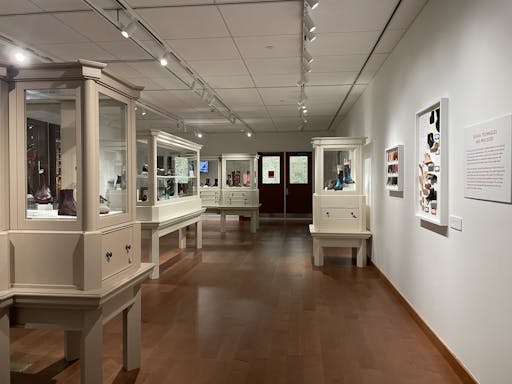The "Hand Made in America: Contemporary Custom Footwear" exhibition within the School of Human Ecology honors 11 different shoemakers' functional, undying artistry. Curator Amara Hark-Weber's background as a professional shoemaker distinguishes the space, where viewers can interact with the shoemaking process from conceptualization and construction to completion.
The Helen Louise Allen Textile Collection has featured a series of globally sourced shoes from China, Lebanon, Bosnia, Herzegovina and Turkey that date throughout the 1900s. The United States artists featured include Hark-Weber, Daphne Board, Francis Waplinger, Greg Carmack, Jesse Moore, Lee Miller, Lisa Sorrell, Marcell Mrsan, Paul Krause, Rachel Corry and Sarah Madeleine T. Guerin.
Some examples of the featured designs include Miller's pink star-embellished cowboy boots, Sorrrell's "Wild and Blue" flower embellished leather boots and Carmack's boots decorated with portraits of majestic women.

The space mirrors the mind of an artist. Unlike in traditional galleries, the shoes inhibit large display boxes stacked upon drawers that reveal the internal organs of footwear with a pull. Leather paneling, stitch patterns, paper sketches and wood models articulate how materials transform into wearable garments. The setup is complementary to the thorough nature of the meticulous craft. Transparency in design processes helps viewers imagine the relationship between the shoes and their makers, the intentions behind custom garments and the humanity behind hand-made shoes.
A television in the exhibit displays a compilation of videos that each maker recorded. It gives viewers an inside look into the featured shoemakers' spaces. In Guerin's video, she explains that as an American shoemaker, she is "grateful" that the traditions of U.S. footwear are carried out in her work space.
"There's three lives to shoes. There's the making life, then there's the life where it's brand new and then there's the life that it's worn, which is really long, hopefully," said curator and featured artist Hark-Weber.
"Having parts of the process available to the viewer was important to me," said Hark-Weber.
Hark-Weber's current work is based in St. Paul, Minnesota. She received an MFA at the School of the Art Institute of Chicago, is trained in several shoe types and has received several awards for her work. Having grown up as the daughter of an artist and craftsman, she's well-acquainted with creative-oriented environments. She makes customized shoes of all kinds and is trained in robust menswear construction techniques with both male and female clients and enjoys working with leather, color and texture.
Each year, Hark-Weber teaches lessons for about a month and finds beauty in preserving the shoemaking craft, she said. In our interview, she eagerly showed a glorious pair of boots with fancy stitching that one of her students was crafting in her studio.
This is the first time she's curated an exhibit, and it's the first time a show of its kind has been displayed in Madison.
"Having something like this in Madison is really a special thing, and I don't know when there will be another shoe show. Hopefully more and more and more," said Hark-Weber.
Hark-Weber highlighted the importance of exceptional craftsmanship and contemporary design. There are few shoemakers in the U.S. and few have made the craft their professional career — this exhibition is unique by design.
Having two young children, Hark-Weber values sustainable footwear and hopes her children will grow up thinking about their decisions behind "things," their "longevity" and develop an "awareness of the world around them." She recognizes there are circumstances and decisions behind the purchases people make, both environmentally and socially.
A pair of Carmack's ostrich leather "kid boots" printed with butterflies and covered with dirt demonstrate the worn life of a cherished shoe. While museums often prioritize art in pristine condition, Hark-Weber purposefully included a worn down pair of boots full of real Texas dirt. They demonstrate shoes' ability to accompany people through life's practicalities.
Shoemaking is "high-skill, high-stakes, high-reward," Hark-Weber said. She expressed immense gratitude to the university, and her passion for craftsmanship radiates throughout the entirety of the exhibit.
The exhibit will last until May 14 in the Lynn Mecklenburg Textile Gallery in Nancy Nicholas Hall, free for viewers to explore.






